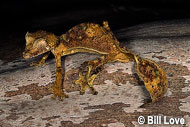Description:
Despite being from tropical forests that receive plenty of rainfall, these petite little devils don’t like to be kept too warm. Temperatures in the 70s to low 80s Fahrenheit work best for them; when it edges toward the upper 80s, it’s definitely getting too hot and is actually dangerous for them. On the opposite end of the spectrum, nightly temps can drop into the low 60s and even upper 50s and be tolerated quite well. Such seemingly radical change is normal for satanic leaf-tailed geckos in nature and should be duplicated in captivity for the best long-term results in maintaining and breeding them. Potting soil or mulch works well as a substrate. Mist the cage often so a high humidity is upheld, but the air must not stagnate. Moderate air movement through the cage is necessary to avoid mildew and mold from growing. Add several plants with numerous small branches and leaves that these lizards may climb through and explore. The satanic leaf-tailed gecko prefers small brush, not large trees. Supply assorted small insects, but only in numbers that will be consumed nightly. You must add them sparingly at first until you’ve determined how many make up a normal meal. Put them in the cage at dusk when satanic leaf-tailed geckos come out to forage.
Habitat:
Lush forests
Range:
Madagascar
Scientific Name: Uroplatus phantasticus
Species Group: gecko
Family: Gekkonidae
Size: 3 to 6 inches
Level: intermediate
Weight:
Dangerous: No



